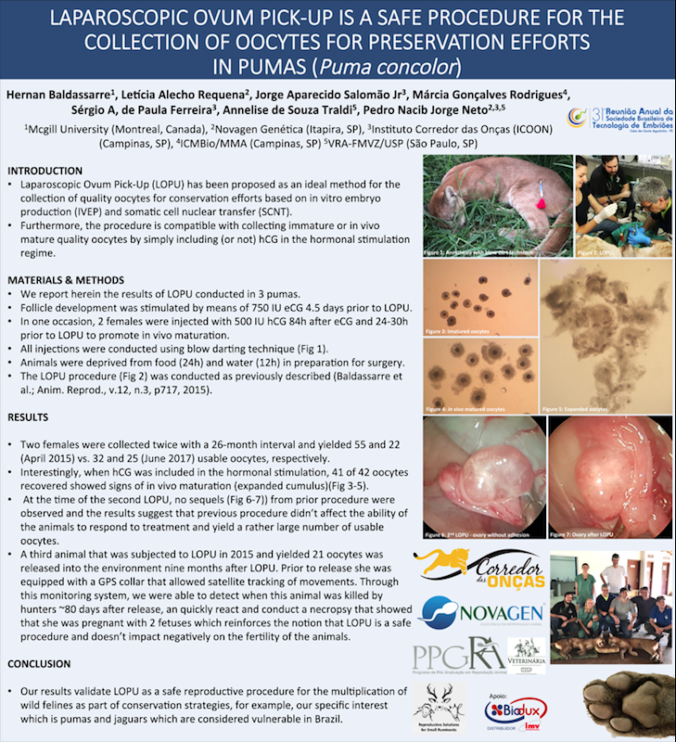
04.09.2018
Laparoscopic Ovum Pick-Up (LOPU) has been proposed as an ideal method for the collection of quality oocytes for conservation efforts based on in vitro embryo production (IVEP) and somatic cell nuclear transfer (SCNT). Furthermore, the procedure is compatible with collecting immature or in vivo mature quality oocytes by simply including (or not) hCG in the hormonal stimulation regime. We report herein the results of LOPU conducted in 3 pumas. Follicle development was stimulated by means of 750 IU eCG 4.5 days prior to LOPU. In the first stimulation, 2 females were injected with 500 IU hCG 84h after eCG and 24-30h prior to LOPU to promote in vivo maturation. All injections were conducted using blow darting technique. Animals were deprived from food (24h) and water (12h) in preparation for surgery. The LOPU procedure was conducted as previously described (Baldassarre et al.; Anim. Reprod., v.12, n.3, p717, 2015). Briefly, the females were restrained on a laparoscopy table in a 45° angle and then, using a 5 mm laparoscope and an atraumatic grasping forceps to uncover the ovaries, all follicles ≥ 2 mm diameter were aspirated using a 20G needle mounted in a plastic pipette connected to a collection tube and vacuum line. Interestingly, when hCG was included in the hormonal stimulation, 41 of 42 oocytes recovered showed signs of in vivo maturation (expanded cumulus). Two females were collected twice with a 26-month interval and yielded 55 and 22 (April 2015) vs. 32 and 25 (June 2017) usable oocytes, respectively. No sequels from prior procedure (e.g. adhesions, ovarian scars, etc.) were observed and the results suggested that previous procedure didn’t affect the ability of the animals to respond to treatment since they yielded a rather large
number of usable oocytes. The third animal that was subjected to LOPU in 2015 and yielded 21 oocytes was released into the environment nine months after LOPU. Prior to release she was equipped with a GPS collar that allowed satellite tracking of movements. Through this monitoring system, it was possible to detect when and where this animal was killed ~80 days after release, an quickly react and conduct a necropsy that showed that she was pregnant with 2 fetuses which reinforces the notion that LOPU is a safe procedure and doesn’t impact negatively on the fertility of the animals. We believe this is the first report in which LOPU was repeatedly conducted in pumas and reporting fertility after LOPU. Our results validate LOPU as a safe reproductive procedure for the multiplication of wild felines as part of conservation strategies, specifically pumas and jaguars which are considered vulnerable in Brazil.

Read the publication here: Laparoscopic ovum pick-up is a safe procedure for the collection of oocytes for preservation efforts in Pumas (Puma concolor)
